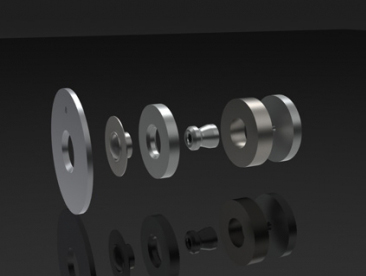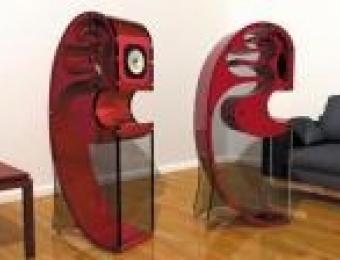Most loudspeakers with any pretensions to high fidelity performance have tweeters. But what does a tweeter do? And how does it do it?
The other name for a tweeter is ‘high frequency driver’. Human beings, at our best (unfortunately, this means in our younger years!) can hear a frequency range of between 20 and 20,000Hz. That is, the pressure waves in the air that constitute audible sound vibrate to and fro between 20 times per second and 20,000 times per second. Hertz means cycles per second.

That is an incredibly wide range. The fundamental frequency of the deepest bass note of a concert grand piano is 27.5Hz, and its highest is a little over 4,000Hz. But we don’t just hear the ‘fundamental’ frequency of a note, we also hear a bunch of harmonics. These are other tones which are whole multiples of the fundamental. That bass note on the piano also produces 55Hz, 82.5Hz, 110Hz and so on. The relative levels of these are a large part of the characteristic sound of any particular musical instrument.
At the other end of the piano keyboard, that top note produces not only 4,186Hz, but also 8,372, 12, 558 and 16,744Hz. And more. But those even higher harmonics are too high to hear for most of us.
Lift up the lid of that grand piano and you will see that the string that produces that 27.5Hz note is huge, fat, weighty. Look at the right hand end of the piano, and you will see that the triplet of strings for the top note are tautly strung, short and light in weight.
This suggests something about the nature of physics: to make higher frequency sounds it’s better to have a smaller sound generator. And that’s what a tweeter is, a small sound generator.
Rapid motion and smaller size
Now let’s look at a conventional speaker system. It typically is a two or three way system with ‘dynamic’ drivers. The ‘engine’ of each of the speaker drivers is a coil inserted into a powerful magnet. The amplifier’s signal is run through the coil, creating a magnetic field which interacts with the fixed magnetic field already there. This makes the coil move. One end of the coil (or, more precisely, the light-weight cylindrical ‘former’ around which it is wound) is attached to the front of the speaker – the bit that you can see. This is usually either a very shallow cone, or a dome.
Remember what I said about sound? It is a pressure wave in the air. This cone or dome has to compress the air: pump it. It is difficult to do this efficiently at high speed, so the size of the pump is kept small.
What frequencies a tweeter covers depends upon the loudspeaker design, but in two way systems (ie. those with a woofer and a tweeter only) tweeters generally handle the frequencies from about 1,500 or 2,000Hz and up. In a three way system (which also have a midrange driver), they could start as high as 4,000Hz.
A crossover network – a passive electronic circuit made up of capacitors, inductors (or coils) and resisters – divides up the frequencies between the drivers.
In high quality loudspeakers they mostly use a dome shape for their surface. This isn’t anything to do with dispersing the sound in different directions, but because a partial sphere is a very strong shape that can withstand the rapid accelerations with little if any physical distortion. It also means that the former around which the magnetic coil is wound can be as wide as the dome – commonly 25mm.
Why would that matter?
All loudspeakers are extremely inefficient. The majority of the electrical energy you pump into them from your amplifier is simply turned into waste heat. And almost all of this happens in the magnetic coils of the drivers.
A common mode of failure for loudspeaker drivers is damage due to overheating. It isn’t normally that the coil melts or anything, but that continual excessive heating can cause warping, or damage the glue that holds it in place. The larger the coil, the greater the area to radiate the heat, and therefore the greater resistance to damage.
Happily, through one of those pleasing coincidences of nature, in both the real world and in music, the levels of sound at different frequencies are very different in intensity. Deep bass sounds require much higher levels and far more power than mid-range sound. And those in turn require more power than high frequency sounds. Even in a two way system where the tweeter is coping with frequencies from as low as 1,500Hz, all the way up to 20,000Hz, it is only receiving a small proportion of the power from the amplifier most of the time. The rest is going to the woofer, which has a much larger coil.
Another important reason for a small driver is to aid the dispersion of sound. The higher the frequency of the sound, the shorter its wavelength. As the wavelength approaches the size of the speaker cone or dome that is producing it, it tends to become more directional. If it is smaller than that cone or dome, it tends to beam rather than spread around the room. At 2,000Hz, the wavelength of sound is already down to 171cm, or the size of a large woofer. Wide dispersion of treble is necessary for an airy, balanced sound.
Super tweeter
If you look at the specifications for a hundred high quality loudspeakers, more than half will likely say that their frequency response extends up to 20,000Hz. Some may say 22,000 or 25,000 even. But there is a few that offer 30,000 or even more.
Many of these incorporate a ‘super tweeter’. This is, basically, just another tweeter designed to work better with even higher frequencies. But why have such a thing?
They are useless for CDs, of course, since a CD tops out at 20,000Hz. But some of the newer digital audio formats such as SACD, DVD Audio and, of course, Blu-ray, are capable of carrying much higher frequencies. In the case of Blu-ray, the theoretical top of the frequency range is just under 96,000Hz!
Whether that makes any actual difference to the audible sound is a subject of high dispute among audiophiles. But be aware that many of the great loudspeakers of the world are designed to handle up to 20,000Hz only.
Doing it differently
Now there is rarely in consumer electronics only one technical solution to any given problem, and so it is with tweeters. The differences can be as mundane as the use of different materials in the construction of the cone: a finely woven silk dome is popular with some, while plastic formulations are used with others and metal domes (usually with magnesium, titanium or aluminium) are often used as well.
Or they can be radically different. Ribbon tweeters have a flat coil attached to the vibrating diaphragm itself, with the whole thing suspended in a strong magnetic field. Most of the moving surface is thus directly supported. Compression drivers use either a conventional tweeter, or sometimes a piezo-electric tweeter (in which a crystal physically vibrates under the influence of an electrical signal) coupled to the air by means of a horn. The horn makes them far more efficient.
Some loudspeaker makers have even experimented with ‘plasma’ drivers. These ionise a small sphere of air, and then make this pulsate under the control of the electrical signal. These apparently have unfortunate health effects, though, so they are rarely used.
Doing without
Finally, some just do without tweeters altogether. This can be for reasons of cost, or of size (e.g. tiny satellite speakers). Or some just work differently. Electrostatic loudspeakers, for example, apply a strong electrostatic charge to a large sheet of metallised diaphragm and then control the electrical field in which this is located. The whole diaphragm moves more or less evenly. Because the whole of the surface is powered, very little movement is required in the higher frequencies, and because the diaphragm is so very light, it can move quickly enough to achieve this.
But these alternatives have their own problems, so the dynamic dome-style tweeter is here to stay for the foreseeable future.





